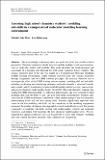Assessing high school chemistry students’ modeling sub-skills in a computerized molecular modeling learning environment
Author(s)
Kaberman, Zvia; Dori, Yehudit J
Download11251_2011_Article_9172.pdf (950.8Kb)
PUBLISHER_POLICY
Publisher Policy
Article is made available in accordance with the publisher's policy and may be subject to US copyright law. Please refer to the publisher's site for terms of use.
Terms of use
Metadata
Show full item recordAbstract
Much knowledge in chemistry exists at a molecular level, inaccessible to direct perception. Chemistry instruction should therefore include multiple visual representations, such as molecular models and symbols. This study describes the implementation and assessment of a learning unit designed for 12th grade chemistry honors students. The organic chemistry part of the unit was taught in a Computerized Molecular Modeling (CMM) learning environment, where students explored daily life organic molecules through assignments and two CMM software packages. The research objective was to investigate the effect of the CMM learning unit on students’ modeling skill and sub-skills, including (a) drawing and transferring between a molecular formula, a structural formula, and a model, and (b) transferring between symbols/models and microscopic, macroscopic, and process chemistry understanding levels. About 600 12th grade chemistry students who studied the CMM unit responded to a reflection questionnaire, and were assessed for their modeling skill and sub-skills via pre- and post-case-based questionnaires. Students indicated that the CMM environment contributed to their understanding of the four chemistry understanding levels and the links among them. Students significantly improved their scores in the five modeling sub-skills. As the complexity of the modeling assignments increased, the number of students who responded correctly and fully decreased. We present a hierarchy of modeling sub-skills, starting with understanding symbols and molecular structures, and ending with mastering the four chemistry understanding levels. We recommend that chemical educators use case-based tools to assess their students’ modeling skill and validate the initial hierarchy with a different set of questions.
Date issued
2011-08Department
Massachusetts Institute of Technology. Center for Educational Computing InitiativesJournal
Instructional Science
Publisher
Springer Netherlands
Citation
Dori, Yehudit Judy, and Zvia Kaberman. “Assessing High School Chemistry Students’ Modeling Sub-Skills in a Computerized Molecular Modeling Learning Environment.” Instructional Science 40.1 (2012): 69–91.
Version: Author's final manuscript
ISSN
0020-4277
1573-1952